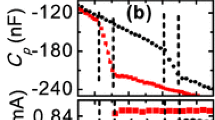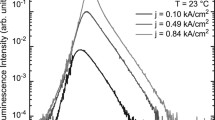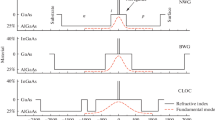Abstract
We experimentally investigate and analyze the electrical and optical characteristics of InGaAs/GaAs conventional quantum well laser diode and the quantum well laser diode with slightly-doped tunnel junction. It was found that the laser with slightly-doped tunnel junction has a nonlinear S-shape current-voltage characteristic. The internal quantum efficiencies of the laser with slightly-doped tunnel junction and the conventional laser are 21 and 87.3%, respectively. This suggests that the slightly-doped tunnel junction increased the barrier width and free carrier absorption, thus could reduce the electron tunneling probability and increase the internal loss. Furthermore, compared with the conventional laser, it was found that we could achieve 15 nm broadband spectrum from the laser with slightly-doped tunnel junction, due to the lasing dynamics reflecting the current dynamics. The results show that the slightly-doped tunnel junction plays a crucial role in the laser diode performances, which may lead to the realization of more applications.
Similar content being viewed by others
Avoid common mistakes on your manuscript.
1 INTRODUCTION
Semiconductor laser diodes (LDs) are used at present in a variety of fields in science and technology. Tunnel junction (TJ), which was proposed by Esaki [1], has been widely used in many semiconductor LDs for different applications. Overview the TJ semiconductor LDs, there are mainly three different kinds of structures: First, a reverse-biased TJ comprised of heavily doped p-type and n-type layers is located between adjacent LDs, to provide good electric contact [2]. This kind of semiconductor LDs can enhance the quantum efficiency and output optical power. The principle of these devices is to inject one electron-hole pair into the active regions to produce N times electron-hole pairs through cascaded TJs, where N is the number of the active regions. The internal quantum efficiency of the cascaded lasers can be much larger than unity while for conventional LDs. Second, dual-wavelength lasers based on the bipolar cascade lasers (BCL) with a similar structure also have been demonstrated [3]. The dual-wavelength BCL is composed of two different active regions with different multi-quantum-wells (MQWs), and the active regions are connected by a very thin reverse-biased TJ. The TJ requires materials with high n-type and p-type doping levels, low dopant diffusion, and large band gaps to avoid absorption. Third, the forward-biased TJ with high doped n-type and p-type layers locates on the top of a LD [4]. The negative differential resistance (NDR) of the TJ has been used in optical bistable devices, which are the key components in future optical switching and computing systems. The principle of these devices is that the tunnel diode section provides a differential negative resistance, which induces an electrically bistable characteristic, when connected in series with the laser section and an external load. Thus the coherent light output from the device displays a negative differential optical response and bistable effects in response to an applied voltage. Optical bistable devices have very large application prospects in the all-optical data switch [5], all-optical signal amplification [6], optical pulse width compression and signal shaping [7], all-optical signal reproduction [8] and many other signal processing. In practical applications, the optical bistable switch requires a high switching speed and a low forward voltage drop, to increase the switching frequency and reduce switching losses and forward conduction losses. In the general case, the electrical bistability with two equilibrium states can be obtained in a thyristor heterostructure [9]. The thyristor structure has a variety of advantages for optical switch, such as low switching energy, low power consumption, fast response, high on/off contrast, and expansibility to two-dimensional monolithic array [10–13].
In these TJs, the high-doping of the layers composing TJ plays a crucial role for optimizing and engineering device properties. Recently the slightly-doped TJ LDs have been reported to achieve the broadband stimulated emission [14, 15]. However, the mechanisms behind these principles are not revealed yet, furthermore, how the slightly-doped tunnel junction determine the laser performance has also not been unrevealed in the reported literatures.
In this letter, we report GaAs/InGaAs quantum well lasers with the slightly-doped p–n+ GaAs–GaAs reverse-biased TJ located below the upper cladding layer. The electronical and optical properties are investigated and analyzed compared with conventional LDs. Our studies show that the TJ LD has a nonlinear S-shape I–V characteristic, and the internal quantum efficiencies of the TJ LD and the conventional LD are 21 and 87.3%, respectively. This suggests that the slightly-doped TJ increased the barrier width and free carrier absorption, thus could reduce the electron tunneling probability and increase the internal loss. Furthermore, compared with the conventional LD, it was found that we could achieve 15 nm broadband spectrum from the TJ LD due to the lasing dynamics reflecting the current dynamics. Detailed fabrication procedures and the electro-optical properties of the fabricated LDs will also be discussed.
2 DEVICE STRUCTURE AND FABRICATION
Samples used in this study were grown on a heavily n-doped GaAs substrate via Metal Organic Chemical Vapor Deposition (MOCVD) using only one step growth. Figures 1a and 1b schematically depict the structures of the conventional LD and the slightly-doped TJ LD, respectively. For the conventional LD, we first deposited a 400-nm-thick n-GaAs buffer layer, a 1.8-μm-thick n-AlGaAs cladding layer, a 100-nm-thick AlGaAs and a 400-nm-thick GaAs separate confinement heterostructure (SCH) layer. Subsequently, a active region consisting of 2 pairs of 5-nm-thick InGaAs well layers and 15-nm-thick GaAs barrier layers was deposited. A 100-nm-thick AlGaAs, a 400-nm-thick GaAs SCH layer, a 1800-nm-thick p-AlGaAs cladding layer and a 300-nm-thick p+-GaAs contact layer were then grown on top of the MQWs active region, as shown in Fig. 1a.
For the slightly-doped TJ LD, we deposited the TJ structure on top of the conventional LD, as shown in Fig. 1b. It should be noted that the growth condition for the TJ LD structure is identical to that for the conventional LD. On the other hand, the TJ structure consists of a 10-nm-thick n++-GaAs layer, a 8-nm-thick undoped GaAs layer, as shown in Fig. 1c. After the growth, standard Fabry-Perot laser procedures were then used to fabricate a ridge waveguide with a width of 4 μm and a depth of 2.2 μm. A silicon dioxide insulating layer was grown by Plasma-Enhanced Chemical Vapor Deposition (PECVD). Then Ti/Au metal p-contacts and Au/Ge/Ni n-contacts were deposited. Finally, the wafers were cleaved into 300 × 200 μm individual chips with both facets left uncoated. (as-cleaved).
3 RESULTS AND DISCUSSION
3.1 I–V Characteristics of the Conventional LD and the TJ LD
Current-Voltage (I–V) characteristics measured from these devices were plotted in Fig. 2. It was found that the conventional LD has a normal p–n diode characteristic with the threshold voltage of 1.2 V. But for the TJ LD in the forward bias, it shows a nonlinear S-shape I–V characteristic, and has three distinct states: (1) high-impedance forward blocking region (off-state), (2) negative-resistance region, and (3) low-impedance and high-conductance forward-conducting region (on-state). In general, the p–n junction grown by MOCVD is regarded as being approximately abrupt. The reverse-biased avalanche breakdown voltage Vb0 of GaAs abrupt junction is given by the following formula [16]:
where Eg is the bandgap of GaAs material, and Nb is the ionised impurity concentration in cm–3 in the lightly doped region. When the growth temperature of undoped GaAs is 780°C, the background doping impurities are mainly C, with a value of about 3 × 1017 cm–3. Vb0 is 6.9 V calculated based on Eq. (1). The measured block voltage (Vb) and current (Ib) are 9.6 V and 3 mA, respectively. The holding voltage (Vh) and current (Ih) are 3.9 V and 7.8 mA, respectively. The lasing device with an S-shaped I–V characteristic can dedicate to the optical switching application [17].
When the bias voltage increases from 0 to Vb, the TJ LD is in the off-state, but the on-state will begin after voltage touched Vb. However, when the bias voltage decreases, the TJ LD is in the on-state as long as the voltage is over Vh. It is worth mentioning that the TJ LD can turn on immediately [9, 18]. In the on-state, the device can emit light as a laser, if the current is greater than the threshold. Consequently, this device has the potential to provide output power bistability. The voltage threshold of the TJ LD is Vth, which almost close to Vh. When the voltage increases from 0 to Vb, the TJ LD can’t emit light, due to the current less than Ith. However, when the voltage decreases from Vb to Vth, the current is greater than Ith, and the TJ LD will send out laser.
3.2 P–I Characteristics of the Conventional LD and the TJ LD
Power–Current (P–I) characteristics measured from the conventional LD and the TJ LD were plotted in Fig. 3. Compared to the conventional LD, the TJ LD has a large threshold current and a low slope efficiency. The current threshold of the TJ LD is 36 mA, which is three times higher than conventional LD. With an output power of 20 mW, it was found that injection currents for the conventional LD and TJ LD were 82 and 172 mA, respectively. The output power (P0) above the threshold current (Ith) can be expressed as [19]:
where ηd is the differential quantum efficiency, also known as the slope efficiency of the laser, hν is the energy per photon, q is the electronic charge, Ith is the threshold current, ηi is the internal quantum efficiency, 〈αi〉 is the average internal loss, L is the cavity length of the laser, R the facet reflectivity, and R ≅ 0.33.
Equation (3) gives a linear dependence and it is widely used to determine the average internal loss and internal quantum efficiency, by measuring the differential quantum efficiencies for different cavity lengths [19]. And the results of the conventional LD and the TJ LD are shown in Fig. 4. Conventional LD internal quantum efficiency is 87.3% and the average internal loss is 0.85 cm–1. TJ LD internal quantum efficiency is 21% and the average internal loss is 6.9 cm–1. The low internal quantum efficiency and the high average internal loss lead to the low output power and the high current threshold for the TJ LD. This is because the slightly-doped TJ increased the barrier width and free carrier absorption. As a result, the electron tunneling probability reduces, the effective resistivity of the TJ and the internal loss increase. High-resistive layers can be the reason for a strong lateral current spreading in the laser and, as a consequence, lower differential quantum efficiency and higher threshold currents.
Inverse slope efficiency 1/d versus laser length L as measured. Linear regression results are given as lines together with the parameters of Eq. (3).
3.3 Spectral Characteristics of the Conventional LD and TJ LD
Figures 5a and 5b show electroluminescence (EL) spectra measured from the conventional LD and the slightly-doped TJ LD, respectively. It can be seen that EL peaks occurred indeed at around 1060 nm for both LDs, as designed. It was also found that the peak wavelength of the conventional LD shifts from 1055 to 1058 nm with increasing injection current, which hints that wavelength tenability can be easily achieved not only through a temperature change, but also by adjusting the operation current. But for the slightly-doped TJ LD, it shows the broadband emission characteristic, as the injection level is increased to 4.5 × Ith, the spectrum broadens toward a longer wavelength and gives a 15 nm broad spectrum. This is because that the lasing dynamics reflects the current dynamics formed as a result of complex nonlinear couplings within the laser-thyristor heterostructure [20]. The spectrum can be further broad with the increased injection current [21].
4 CONCLUSIONS
In conclusion, We experimentally investigate and analyze the electrical and optical characteristics of InGaAs/GaAs conventional LD and TJ LD. It was found that the TJ LD has a nonlinear S-shape I–V characteristic, but the slightly-doped TJ increased the barrier width and free carrier absorption, resulting in reduced electron tunneling probability and increased internal loss. The experimentally obtained internal quantum efficiencies of the TJ LD and the conventional LD are 21 and 87.3%, respectively. Furthermore, compared with the conventional LD, we could achieve 15 nm broadband spectrum from the TJ LD, due to the lasing dynamics reflecting the current dynamics. The results may also lead to the realization of more applications, such as mode locking with ultra-short pulse generation, biomedical imaging, broad wavelength tenability, and multiwavelengths generation.
REFERENCES
L. Esaki, Phys. Rev. 109, 603 (1958).
J. P. van der Ziel and W. T. Tsang, Appl. Phys. Lett. 41, 499 (1982).
J. Yan, J. Cai, G. Ru, et al., in Proceedings of the Conference on Lasers and Electro-Optics, 2006.
J. Mi, H. Yu, H. Wang, et al., IEEE Photon. Technol. Lett. 27, 169 (2015).
M. Shirdel and M. A. Mansouri-Birjandi, Front. Optoelectron. 9 (4), 1 (2016).
F. Ricci, R. A. Rica, M. Spasenovic, et al., Nat. Commun. 8, 15141 (2017).
E. Yousefi and M. Hatami, Optik (Munich, Ger.) 125, 6637 (2014).
T. Mori, Y. Sato, and H. Kawaguchi, J. Lightwave Technol. 26, 2946 (2008).
S. O. Slipchenko, A. A. Podoskin, V. V. Vasil’eva, et al., Semiconductors 48, 697 (2014).
K. Hara, K. Kojima, K. Mitsunaga, et al., Opt. Lett. 15, 749 (1990).
W. K Chan and A. C. von Lehmen, US Patent No. 5132982 (1992).
F. R. Beyette, K. M. Geib, S. A. Feld, et al., IEEE Photon. Technol. Lett. 5, 686 (1993).
A. G. Kirk, H. Thienpont, A. Goulet, et al., IEEE Photon. Technol. Lett. 8, 464 (1996).
H. Wang, X. Zhou, H. Yu, et al., Appl. Phys. Lett. 104, 251101 (2014).
H. Wang, H. Yu, X. Zhou, et al., Appl. Phys. Lett. 105, 141101 (2014).
S. W. Wang, R. H. Wu, Q. G. Zhu, et al., Chin. J. Laser. 129, 306 (1980).
G. W. Taylor and H. Opper, IEEE J. Quantum Electron. 53 (3), 1 (2017).
H. Wang, J. Mi, X. Zhou, et al., Opt. Lett. 38, 4868 (2013).
L. A. Coldren and S. W. Corzine, Diode Lasers and Photonic Integrated Circuits (Wiley, Chichester, 1995).
S. O. Slipchenko, A. A. Podoskin, A. V. Rozhkov, et al., J. Appl. Phys. 116, 819 (2014).
J. Pan, L. Zhen, H. Wang, et al., in Proceedings of the International Conference on Optical Communications and Networks, 2015.
ACKNOWLEDGMENTS
We thank all the teachers and students in the PIC group of the Key Laboratory of Semiconductor Materials Science for their help.
The study was supported by the National Key Research and Development Program of China under grant no. 2017YFB0405301, and the National Natural Science Foundation of China under grant no. 61604144, grant no. 61504137.
Author information
Authors and Affiliations
Corresponding author
Additional information
The article is published in the original.
Rights and permissions
About this article
Cite this article
Yajie Li, Wang, P., Meng, F. et al. Investigation of InGaAs/GaAs Quantum Well Lasers with Slightly Doped Tunnel Junction. Semiconductors 52, 2017–2021 (2018). https://doi.org/10.1134/S1063782618160169
Published:
Issue Date:
DOI: https://doi.org/10.1134/S1063782618160169









